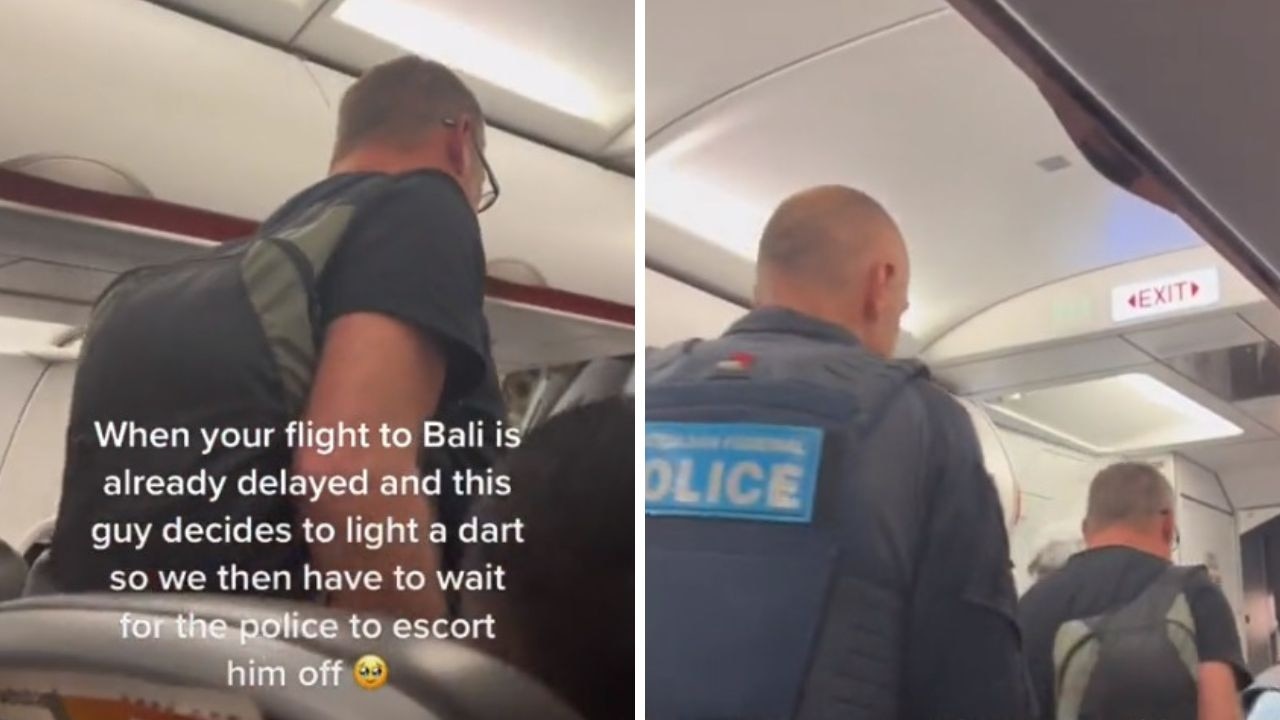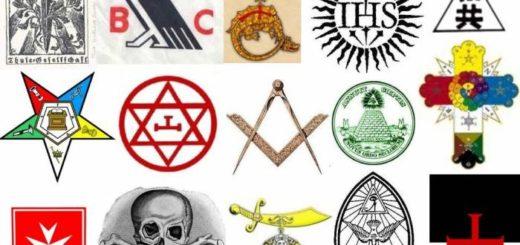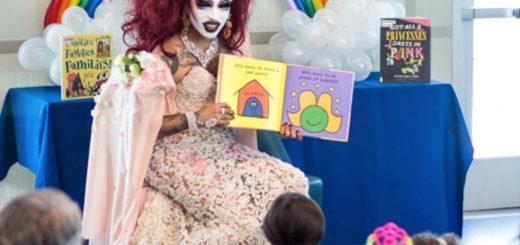STORY HIGHLIGHTS
Kim Phuc is well-known as the terrified young girl in an iconic photo from the Vietnam War
A Miami doctor is treating her scars with laser therapy
You’ve probably seen the iconic photograph: a little girl, naked and crying, running on a road after a napalm bomb attack during the Vietnam War.
The girl in the famous 1972 picture was badly burned but survived. If you met her today, Kim Phuc’s warm smile would grab your attention before you even noticed her scars. You also would never know that she is in constant pain – from the moment she wakes up in the morning, to her last thought at night.
“I just pray God help me and I dreamed that one day in heaven, I don’t have any more pain and anymore scars,” Phuc says. “But now, right now, it’s my dream come true. Heaven on Earth for me … and I’m so happy, happy, happy.”
Phuc has found new hope, thanks to fractional ablative laser therapy. Dr. Jill Waibel, a board-certified dermatologist in Miami, says the treatment, which was initially developed to reduce wrinkles, can help burn and trauma patients heal their scars.
“We’re literally going to steam the scar tissue away,” she said. “And those little, tiny holes where we vaporize the scar, the body will heal as normal skin.”
The results, Waibel said, go beyond what the eye can see.
“The first improvements we usually see in our burn and trauma patients is their itching and their pain is decreased,” she said. “Then a few weeks after the laser, you’ll see an improvement in the texture (of the skin.) It’ll get smoother. And somewhere in between there, range of motion will improve. We have patients that call us literally the next day to say, ‘I can move my arm. I haven’t been able to do this in 10 years.’ “
Each session costs from $500 to $3,000, and Waibel said the treatment isn’t typically covered by insurance. She is giving Phuc the treatments for free.
“She’s such a beautiful soul,” Waibel said. “She’s so spiritual, and for someone that’s been through her journey, I was really very impressed with her.”
‘I hated my life’
Phuc’s journey hasn’t been easy. For years, she struggled to come to terms with what happened. She was just 9 years old when the napalm disfigured parts of her body. Her childhood was destroyed.
“My heart was full of hatred, I hated my life,” Phuc said. “Every time I look at my scar, I hated it and every time I got the pain … I couldn’t bear that. I almost give up, but then it’s amazing turning point, when I prayed, ‘God, please help me.’ “
Phuc, who became a Christian at 19, turned to her faith to heal her emotional wounds.
“(Faith) has helped me, give me thankful heart,” she said. “To be here in this life and to have another chance in my life, it’s a miracle. I was supposed to be dead.”
Related: Kim Phuc’s journey from war to forgiveness
But the physical pain associated with the scars remains. Phuc stopped taking pain medication 14 years ago, choosing instead to work through the pain by going for a walk, talking on the phone or even singing a song.
“I learned to distract my mind when the pain comes. I never focus on the pain,” she said. “I just learned that when I focus on the pain, it gets bigger and bigger and bigger. I stopped thinking about that.”
A chance for a new life
Phuc is married and has two grown sons. She and her husband claimed asylum in Canada more than 20 years ago, and they travel the globe for the Kim Foundation International. Its mission is to help children touched by war. The pain makes traveling difficult.
“It’s not really fun, you know, when I just endure with the pain,” she said.
So far, Phuc has had two laser therapy sessions at Waibel’s Miami office. She has several more to go. Even though the entire treatment will probably take a year to complete, she has already noticed some improvement in the texture of her skin. She’s excited about the possibility of a pain-free life.
“I really want to get better, better in my life in order I can do more things,” Phuc said. “I look forward in the future, one day … no pain. That will be wonderful.”
Uncle Satan’s horrific legacy: The children of Agent Orange. Straight From HELL.
Comment
FORTY years after the end of the Vietnam War the crippling effects of Agent Orange, a chemical sprayed during combat, are revealed. WARNING: GRAPHIC IMAGES

These pictures are of Hien whose 12 children have passed away from the effects of Agent Orange. He has built a shrine where his children are buried, on top of a dune beside his home. Photo: Ash Anand / NEWSMODO
FORTY years after the end of the Vietnam War this is a country which should be rising back to its feet.
Instead it is crippled by the effects of Agent Orange, a chemical sprayed during combat, stripping leaves off trees to remove enemy cover.
Its contaminant, dioxin — now regarded as one of the most toxic chemicals known to man — remains in Vietnam’s ecosystem, in the soil and in the fish people eat from rivers.
Nearly 4.8 million Vietnamese people have been exposed, causing 400,000 deaths; the associated illnesses include cancers, birth defects, skin disorders, auto-immune diseases, liver disorders, psychosocial effects, neurological defects and gastrointestinal diseases.
According to the Red Cross of Vietnam, up to one million people are currently disabled or have health problems due to Agent Orange, 100,000 of which are children.
In Ho Chi Minh City’s Go Vap orphanage, five-month-old Hong gazes serenely from her metal-barred cot, empty, save for a soft yellow teddy bear watching over her.
From her head grows a huge veiny mass — a rare neural tube defect known as encephalocele, which research suggests could be caused by Agent Orange exposure.
Without successful surgery, Hong’s future is bleak. She could suffer from paralysis of the limbs, vision impairment, mental disability and seizures.
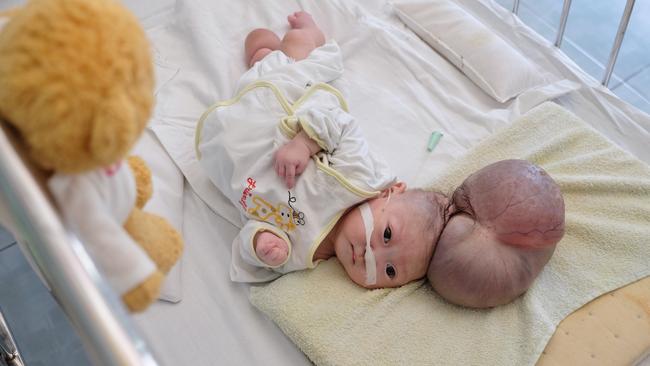
Hong Tu, 5 months old, with Encephalocele — a rare neural tube defect characterised by sac-like protrusions of the brain and the membranes that cover it through openings in the skull. Photo: Ash Anand / NEWSMODO

Phan Thanh Hong Duc, aged 19, suffering from microcephaly (an abnormal smallness of the head, a congenital condition associated with incomplete brain development). Photo: Ash Anand / NEWSMODO
In the capital’s Tu Du Hospital, within the Children’s Agent Orange ward lives 13-year-old Tran, with Fraser Syndrome. A rare genetic disorder, it’s characterised by completely fused eyelids, partially webbed fingers and toes and genital malformations. Tran’s nurses explain how he spends hours each day crying out relentlessly, rocking himself back and forth in his cot.
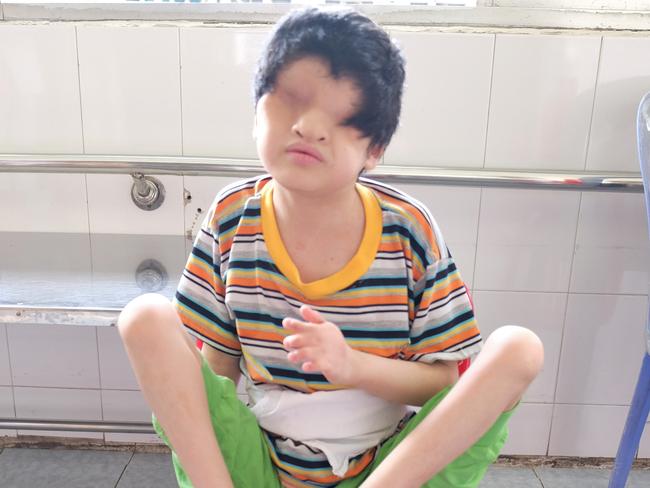
Tran Huynh Thuong Sinh, aged 13, with Fraser Syndrome — a rare genetic disorder characterised (as in Tran’s case) with partial webbing of the fingers and/or toes, kidney abnormalities, genital malformations and complete fusion of the eyelids. Photo: Ash Anand / NEWSMODO
Named Agent Orange after the coloured stripe on the barrels it was stored in, the US Army, supporting the South Vietnamese, spent a decade from 1961, spraying approximately 80 million litres over 30,000 square miles of southern Vietnam. The aim was to “smoke out” and weaken the Viet Cong enemy of the north, by decreasing their food supplies.
Studies have shown that dioxin still remains at alarmingly high concentrations in soil, food, human blood and breast milk in people who live near former US military bases.
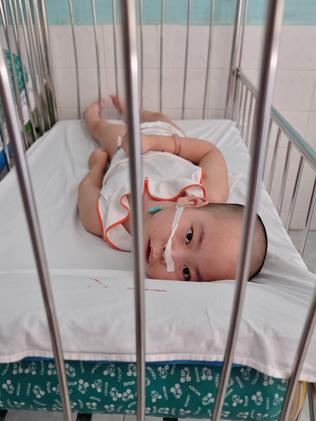
Tra My, aged 9, with hydrocephalus, a condition where fluid accumulates in the brain, enlarging the head and causing brain damage. Photo: Ash Anand / NEWSMODO

Nguyen Minh Anh, aged 21, born with ichthyosis (thought to be unrelated to Agent Orange) and mental illness (his scaly skin led him to be nicknamed Ca, the Vietnamese word for ‘fish’). Photo: Ash Anand / NEWSMODO
But it’s not just families in Vietnam that are affected. Here in Australia, where almost 60,000 troops served in the war, a growing number of veterans, their children and now grandchildren believe they’re battling with the effects of Agent Orange exposure.
Hope White, 39, from the Sunshine Coast, suffers from fibromyalgia, spinal problems and infertility. In 1968, her father was deployed for a year in Vietnam’s Phuoc Tuy Province, which was widely sprayed with Agent Orange.
“I’ve had a number of health problems from a young age — especially with my spine forming. I’m only on my feet through heavy medication, lots of physiotherapy and treatments for my back. I feel like my body’s fighting itself all the time, some days I can’t even get out of bed,” she explains.

Huu Loc, aged three. Photo: Ash Anand / NEWSMODO
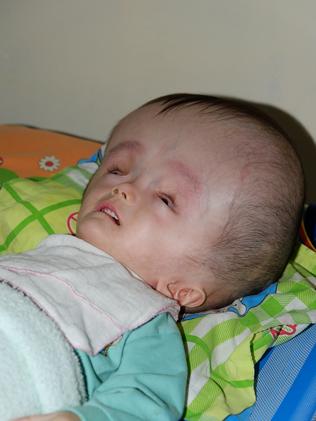
Tu, aged 5. Photo: Ash Anand / NEWSMODO
Although statistics on the number of people affected by Agent Orange in Australia and their associated illnesses aren’t currently recorded, animal studies have shown that exposure to dioxin can lead to female infertility.
“I’ve found that childlessness is very common across the daughters of Vietnam veterans that I’ve spoken with”, says Hope. “It’s had a massive impact on my husband and me. Not having children has changed our lives significantly.”
Dr. Wayne Dwernychuk, a retired senior scientist, adviser with Hatfield and Agent Orange specialist, warns that “countless more generations could be affected in the future”. Research suggests that another six to twelve generations will have to pass before dioxin stops affecting the genetic code.
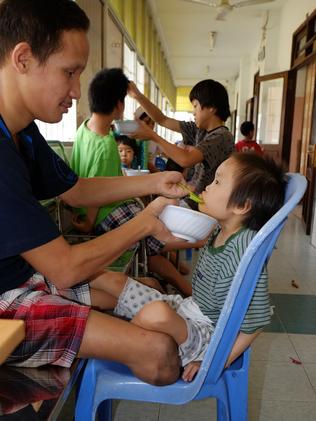
Truong Minh Hiep, aged 16, born with physical deformities feeds breakfast to Tran Thi Ngoc Nhu, aged 8, with Down ’s syndrome. Photo: Ash Anand / NEWSMODO
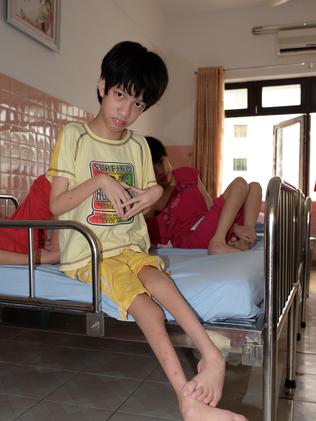
Tran Thi Vy, aged 6, with cerebral palsy and limb stiffness. Photo: Ash Anand / NEWSMODO

These pictures are of Hien whose 12 children have passed away from the effects of Agent Orange. He has built a shrine where his children are buried, on top of a dune beside his home. Photo: Ash Anand / NEWSMODO
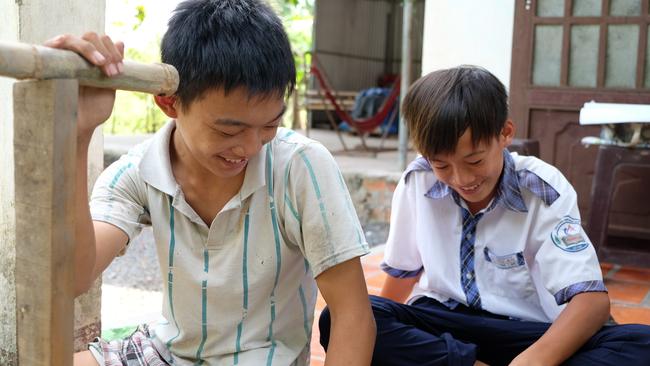
16-year-old Thao in Cu Chi is unable to walk unaided, his legs bound from birth. He practices twice a day on his father’s makeshift rehabilitation walkway, steadied by wooden rails — and waits for funding to come through for an operation. A quiet, timid boy who’s never been to school because of his disability, Thao sits beside his 15-year-old able-bodied brother, Hieu. Their grandfather fought in the war. As in Thao’s case, it’s common for Agent Orange illnesses to skip siblings and even entire generations within the same family. Photo: Ash Anand / NEWSMODO
Support services, however, are steadily increasing for Agent Orange-affected families in Vietnam. In Da Nang, the NGO, Vietnam Association for Victims of Agent Orange, operates two day centres for disabled children, offering vocational training, rehabilitation and the chance to make friends. It’s a safe haven for children often left on the margins of society because of their disabilities.
Charitable donations also help children like 16-year-old Thao in Cu Chi, who’s waiting for funding for an operation on his legs. Unable to walk unaided, his legs bound from birth, he practices twice a day on his father’s makeshift rehabilitation walkway, steadied by wooden rails.
A quiet, timid boy who’s never been to school because of his disability, Thao sits beside his 15-year-old able-bodied brother, Hieu. Their grandfather fought in the war.
“When I see my brother like this, I feel sorry for him”, says Hieu, “I help him at home, sometimes I feed him and we play marbles together around the house.”
“What do you usually do at home?” I ask Thao. “I just lay there. I don’t have anything to do. I don’t feel sad, I’m used to it”. He only has one wish. “I just want to be able to walk,” Thao says quietly.
To make a donation or volunteer your time to help Vietnamese families affected by Agent Orange, visit VAVA (Vietnam Association for Victims of Agent Orange) or SJ Vietnam
http://www.kimfoundation.com/modules/contentpage/index.php?file=intro.htm
Comment: The United States has been taken over by Satan via Secret Satan Societies. Our Presidents are ALL Satan’s Secret Society Members and Molest & even murder children.






